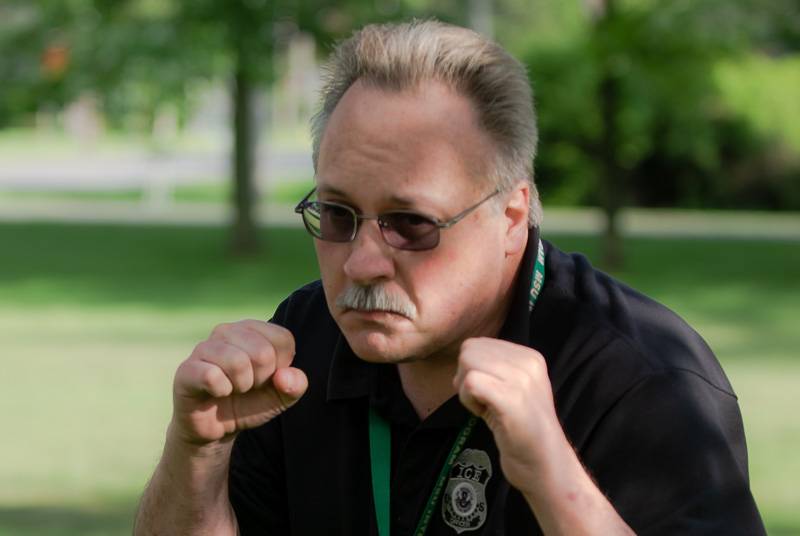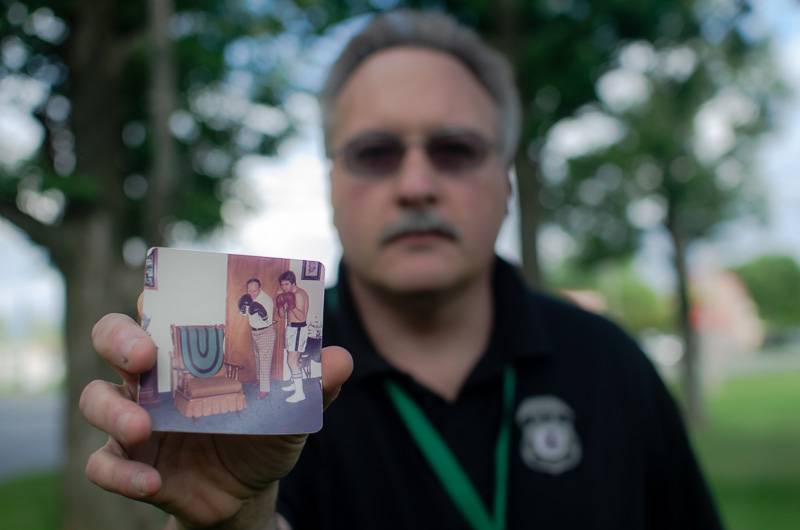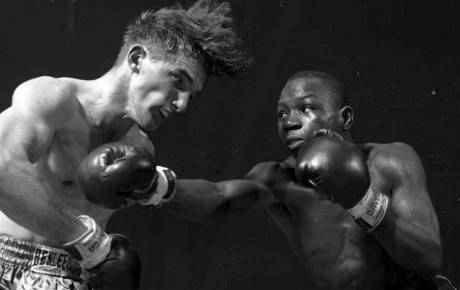Some say, "I could have been a contender." Tim Edgerton got his chance at a title bout and won.
The 52-year-old Oakfield resident grew up in Batavia and fell in love with boxing when he was 15.
It all started on an annual family trip to New Jersey to see his mother's brother. Edgerton's Uncle Norman had been a boxer as a youth. When young Timothy expressed an interest in boxing, they talked a bit and then Uncle Norman took the lad into the basement and dug out his old boxing shorts from a box. Timothy tried them on and they fit. Edgerton said he was hooked.
In the late 1970s, there was only one competitive boxer living in Batavia, and that was Tim Edgerton.
At the time, there were no boxing gyms in Genesee County. The last public boxing ring in Batavia was probably dismantled in the 1950s or early 1960s, or even earlier.
There were still boxers in Batavia, but all were retired from the sport. Most of them fought during Batavia's Golden Era of boxing, the 1930s. One of those former prizefighters was Ken Pixley, who worked with Edgerton's father at Chapin Manufacturing.
According to the book "The Batavia Boxing Club" by Anthony "Butch" Zito, available through the County History Department, Pixley started his boxing career in 1934 as a bantam weight. In his own training, Pixley worked on conditioning and speed, moving in and out, picking his spots. He punched, hooked and jabbed.
Some of the records of Pixley's career are lost, but he never won a title and lost a couple of fights -- and won a few, most notably a 1938 bout in Kibbe Park against lanky Archie Smith of Hamilton, Ontario, in front of 400 local fight fans. Zito writes, "Ken forced the issue from the opening bell and never relented in his attack of left hooks and rights to the head. It was an impressive victory."
Pixley lost his next bout in Rochester later that year. Then he retired from boxing. He was a Mason and served in the Army Air Force during World War ll.
After Pixley learned of Edgerton's interest in boxing, he started working with him, training him.
Edgerton's dad built a boxing ring in the back yard of their home on Sunset Terrace. Pixley lived in a nearby trailer park. He'd help Tim with his training at home.
Once a month Tim's dad drove him to Buffalo to train with John Sudac at Singer's Gym.
It was on the second floor of an old building in a rough part of town. Edgerton said it was like something out of the first "Rocky" film (at the time, a hit movie). When Edgerton's father expressed concern, Sudac lifted his shirt and flashed a revolver. "That takes care of any of the riffraff," he said.
Edgerton had a hard time getting his fellow Batavia High Sschool students interested in boxing (he would eventually graduate from Byron-Bergen and is a member of the Byron-Bergen Hall of Fame). Friends and classmates would agree to spar, but just once. Once was all it took and they'd lose their interest in boxing.
There was an English teacher at BHS at the time, Dave Roberts, who apparently had done a little boxing, and he agreed to spar with Edgerton one summer day between Tim's 9th- and 10th-grade year.
Well, word got around the neighborhood that a teacher was going to fight Edgerton.
"Next thing you know my back yard is filled with 30 or 40 kids and my English teacher thought he was coming up just to spar with me and next thing you know it's turned into a match and it was pretty involved," Edgerton said. "My dad, he didn't want nothing to do with it. He just stayed in the garage and said, 'just let me know when it's over.' "
The late 1970s, those were the days. The top fighters of the day are legends now. Muhammad Ali, George Foreman, Roberto Duran, Ken Norton and Joe Frazier.
In Edgerton's mind, the greatest of them all was Smokin' Joe.
Frazier owned a gym in Philadelphia and one day after school it popped into Edgerton's mind that Philly wasn't all that far away and maybe some day he could train in Frazier's gym.
"So I called up Joe Frazier's gym, and guess who answered the phone?" Edgerton said. "Joe Frazier, Smokin' Joe. He was my idol. I tried to pattern myself after him. I took a lot of hits coming in, but just like Joe -- you get in there and as long as you could wreak some havoc, that was worth it."
It was a nice little conversation, Edgerton said. He explained his situation -- not much in Batavia for boxers and he was thinking of trying to come down to Philadelphia to train for a day.
"He said, you know what, you come down here, you make the effort to come down here, and I'll personally spend some time with you," Edgerton said. "It was great, just talking to him was fantastic."
Alas, Edgerton never made the trip.
"I was pushing it once a month with my dad to go to Buffalo," Edgerton said. "He wasn't going to Philly."
It's a shame Batavia's once thriving boxing scene died out after the 1950s.
At one time in the 1930s, there were at least 40 competitive boxers living in Batavia. Some of the top local fighters of the day included Tony DiCarlo, Norfe Colombo, Joe Goodsell, Nick Tundo, Dick Warboys, Lou Cecere, Butch Zito, Joe Church, Frankie Flynn, Anthony Sciolino, Angelo Yannuzzi and Mickey Devine.
Devine's given name was Joe Cintorino. He was one of a handful of local boxers to turn pro and perhaps the most successful.
The Brooklyn-born Cintorino came to Batavia with his family while still a child. He was coaxed into the gym by DiCarlo. He fought for the first time in 1930 at the American Legion Hall in Buffalo. The decision went to Rochester's Joe Ryan, which sent the crowd into a frenzy of boos -- they thought Cintorino was the better man.
Batavia's Joe Church. Church was a member of the 1936 Olympic Team in Berlin, but was sent home for disciplinary reasons.
A power puncher who could land devastating body blows, Cintorino was known as Batavia's Blonde Terror. By 1932, he was considered one of the top four amateur bantam weights in the nation and was invited to the Olympic Trials in San Francisco. He missed a shot at a state NAA title when a referee, just before the title fight, discovered he was running a high fever and canceled the fight.
Cintorino had a history of lost decisions that were unpopular with fight fans in the crowd. The crowds booed when he lost the final Olympic Trials match to Joseph Lang of San Francisco.
He fought under the name Mickey Devine for the first time later that year in a bout in Rochester representing a group that wasn't sanctioned by the New York Boxing Commission. He beat a fighter from Saratoga Springs that night.
On Nov. 8, 1932, Cintorino beat Canada's reigning bantam weight champion, Jackie Cullura. Zito said it was the biggest bout of his amateur career.
The Blonde Terror turned pro as Mickey Devine in late 1933 and started fighting at 126 pounds.
Devine won his first seven fights and was 7-2-1 when "Ring" magazine named him one of the top featherweight prospects in the nation.
The closest Devine got to a title match was in 1936. The reigning light heavyweight champ, Lou Ambers, kept dodging the fight however, not wanting to take on a talented southpaw.
In 1940, Devine retired with a record of 25-9-2. He died in 1999 and is buried at St. Joseph's Cemetery in Batavia.
It's unclear what happened to boxing in Batavia after 1940. We hear there was boxing locally for at least another decade. Angelo Prospero, who graduated from Batavia HS in 1947 and now lives in South Carolina, is a boxing historian and has written about local boxing. We tried to arrange an interview with Prospero but breaking news on Tuesday and Wednesday got in the way. Hopefully, we can catch up with him some time and find out more.
Whatever happened, it's clear that by the time Edgerton entered the scene, there was no boxing scene in Batavia. He was on his own.
He had Pixley to help. He had Sudac to help. He also bought and watched boxing films -- Joe Louis, Frazier, Ali, Tony Zale and Sugar Ray Robinson.
"I'd watch those fights over and over studying their moves and techniques," Edgerton said.
He had a speed bag and heavy bag in his garage and he would shadow box, trying to imitate what he'd just seen on film.
Uncle Norman had been a pretty good boxer in his local area, but was defeated in his three tries at a Golden Gloves title.
"Tim, I don't know what happened, but the lights went out three times," Uncle Norman told Edgerton. "They carried me out of the ring. Those guys were good, a different caliber."
Edgerton always thought maybe he could win the Golden Gloves title his uncle never did.
First, of course, there had to be a first fight.
Tim lost.
But learned a valuable lesson, one that would eventually make all the difference in the world.
"I was beating the guy pretty good, but I ran out of gas," Edgerton said. "When I went into the fight, I didn't know where I stood as far as conditioning. The second time I dropped my mouth piece, the ref stopped the fight. After that fight, I knew how to train, how to gauge myself, how to pace myself."
By the summer of 1976, Edgerton could drive himself to Rochester to train at Ossie Sussman's gym.He signed up for a 10-week course.
He had been fighting and winning. He was ready for the Golden Gloves championships in Buffalo.
He would have Pixley and Sussman in his corner.
The winter of 1977 was particularly harsh. There was, of course, a blizzard. Twice, the bouts in Buffalo were cancelled.
Still, the Buffallo Golden Gloves organizers needed champions to move onto the next round and time was running short.
"They said they drew names out of a hat to pick the final contestants for each weight class," Edgerton said. "Those people went on to represent Buffalo. When I was looking at the roster, I thought, 'Gee, nobody from outside of Buffalo got selected. It must just be a coincidence.' "
After that, Edgerton thought he needed to buckle down and concentrate on school, so he stepped away from boxing.
Put on the shelf with his gloves was the idea of avenging his uncle's three Golden Gloves defeats.
Edgerton graduated from Byron-Bergen and went to GCC for a year. He then transferred to Sam Houston University in Texas, where he majored in criminal justice.
In Texas, friends encouraged him to box again. He started working out and training and when it came time for the Golden Gloves championship in Houston, he decided to enter.
He drove to Houston with his future wife, Lettie, a Texas girl. He was unaffiliated and only had Lettie to work his corner.
While he was signing up, he noticed a big man in suit watching him. The man motioned him over, so Edgerton walked over. The man asked him if he had anybody to work his corner. Edgerton said he didn't.
The man said he represented the team from Cut and Shoot, Texas. They were a few boxers short for the team and if Edgerton joined their team, they could provide people to work his corner. That way, Ederton gets help and if he scores any points, the Cut and Shoot team gets the points.
That sounded like a fair deal, Edgerton said.
"Of course they had no idea what my skill level was," Ederton said. "They just went into it blind, kind of like I went with them blind."
Then this man from Cut and Shoot, Texas had another proposal for the 174-pound fighter.
"The guy says, 'what would you think about fighting as a heavyweight?' and I said, 'Are you kidding me?' "
Edgerton would be giving up at least 25 pounds to every fighter he faced.
"You'll be giving up a lot of weight, but you're quick, you're fast," the man said. "Jab and move, stay away from them, try to score some points. Your chances are better as a heavyweight. I know some of the kids in the lightweight division. They're really good. I don't know you, but that's the best I can offer."
Edgerton and Lettie talked it over. The man, whom Edgerton still didn't know from a fence post, seemed to know what he was talking about.
After winning the preliminary bouts, Edgerton was facing a man 45 pounds heavier in the finals.
"He had had to go 220 maybe 225 pounds," Edgerton said. "He was bigger. He was taller. and I won. I don't know how. Maybe out of fear. But I was able to take it to him pretty good.
"It did work out where he was bigger and stronger, but he was slower," Edgerton added. "I could out maneuver his punches, you know, duck. A couple of times he swung and I could just literally feel the air rush over head. If he ever hit me, I would have been gone. They would have been carrying me out."
The fight went all three rounds, and for a moment, Edgerton thought he could score a knockout.
"In third round, I almost has had enough to put him down," Edgerton said. "He was stumbling back into the ropes, but I didn't have enough.
"In my corner, they yelled out, 'stick and move, stick and move, you got the fight won, just stick and move,' so that's what I did," Edgerton added. "I got on the bicycle, started sticking, moving, moving, sticking. He couldn't catch me. He was tired. I was in better shape, thank God, and I ended up winning."
With the victory, Edgerton won his Golden Gloves title, and as a heavyweight. Those points also put the team from Cut and Shoot, Texas, over the top for a team championship.
The man who recruited Edgerton turned out to be Roy Harris, once a top professional who made it as far as 12 rounds with the heavyweight champion of his day, Floyd Patterson.
That was Edgerton's last fight. He finished with a career record of 19-6.
Five of those loses were TKOs. Edgerton said he was a nose bleeder and if he got caught on his sniffer, the ref would usually end up calling the fight.
"I thought, thank God I didn't get hurt in all those fights I had and I said, 'that's enough,' " Edgerton said. "The one thing, though, I set the scale straight for my uncle and I proved to myself I could do it."
Edgerton married Lettie and they moved away from Texas. He wanted to return home, but couldn't land a crime-fighting job in Genesee County. He went to work for the U.S. Immigration and Naturalization Service, living in Detroit for a while.
Eventually, the job brought him back to Batavia
In 1993, he developed Operation Child Intercept, which has been adopted nationwide, to combat the illicit transportation of missing and abducted children across the international borders into the U.S.
He currently manages the Immigration and Customs Enforcement’s Criminal Alien Program out of ICE's office in Batavia.
The Edgertons have two daughters, Casey, 20, and Emily, 16. He serves on the Oakfield-Alabama School District Board of Directors.
There was no boxing gym in Batavia for Edgeton when he was growing up, but today's youngsters can't say the same thing.
A few weeks ago, Hands Up MMA opened on Harvester Avenue.
While mixed martial arts is kind of a specialty there, owner Joseph Bailey is a big boxing fan and would love to see more boxers make use of his ring. It's probably the first one in Batavia opened to the public in 50, or maybe 70, years.
Edgerton said he would like to see more young people drawn to the art and science of boxing.
"As long as you do boxing safely and take the right precautions, it's one of the greatest sports and one of the oldest sports for a person to be involved with on an individual level," he said.
The individual nature of boxing is what attracted him to boxing over team sports, he said.
"I love team sports, but that's what intrigued me about boxing," he said. "It's all up to you. You train hard. You climb in that ring, and man, it's just you and that other guy. That other guy is out to try to do harm to you and you're out to try to inflict some punishment on him to win. It changes the whole complexion of everything."
UPDATE: Added photo of Joe Church, sent to us courtesy by Bob Caico, of the Buffalo Veteran Boxing Association.




